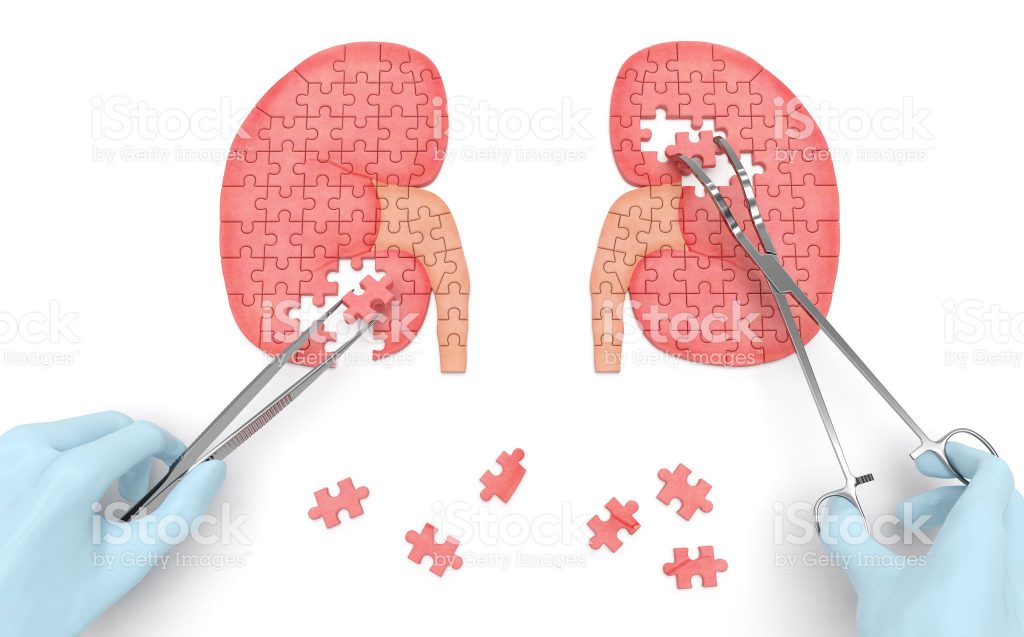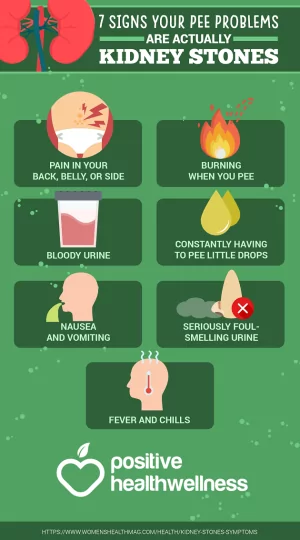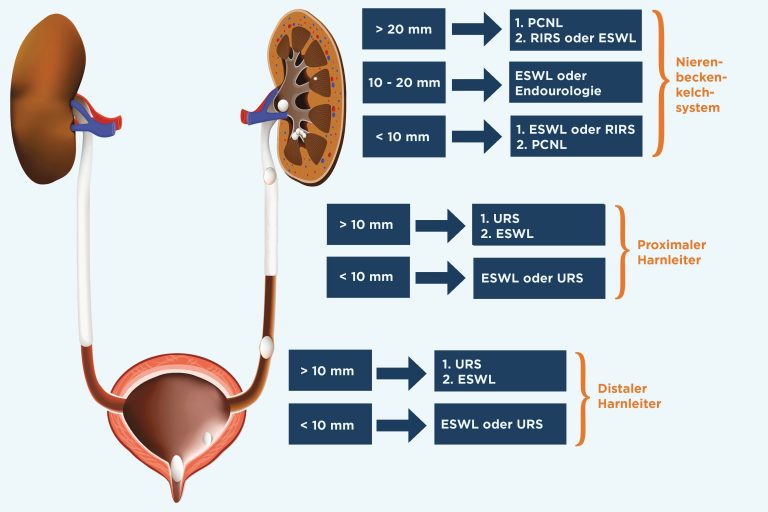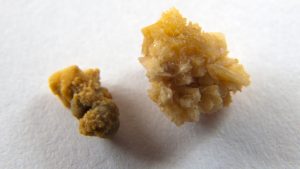
Do I have a kidney stone?
I suspect I have a kidney stone. Should I see a doctor? When should I go to the emergency room?
Go to the emergency room if you have a fever or are vomiting, if your pain is unbearable, or if you stop urinating (this may mean you have a blockage).
If you’re experiencing pain that you think is a kidney stone, visit your doctor and/or urologist. Most doctors are very good at assessing you and your family history as well as factors such as age, weight, sex, prior medical history and current symptoms.
Check to make sure what you think is a stone is actually a stone. The cause of abdominal pain is sometimes difficult to pin down exactly. Pain in your abdomen/ mid-section could be any one of a number of things, including digestive issues, kidney stones, appendicitis, colitis, and diverticulitis to name a few. Remember that kidney stones classically present with flank pain.

The symptoms of a kidney stone are usually one or more of the following:
- Pain on the right or left flank (mid-way between your side and your spine, on your back), sometimes radiating down to the groin (testicles for males, pelvis/ovarian area for females). *The pain is specifically UNDER the rib cage (actually under the diaphragm)
- Pain that comes in waves and fluctuates in intensity
- Pain on urination or urethra spasms
- Pink, red or brown urine
- Cloudy or foul-smelling urine
- Nausea and vomiting
- Persistent need to urinate
- Urinating more often than usual
- Fever and chills if an infection is present
- Urinating small amounts
At the time of a first kidney stone attack, people often aren’t sure what is going on and need to be seen by a doctor to make sure the symptoms aren’t the result of a more serious problem, such as appendicitis.
As a general rule, you need to seek medical attention if you experience any of the following symptoms:
- Severe pain that makes sitting still or getting comfortable impossible
- Pain with nausea and vomiting
- Pain with fever and chills
- Blood in the urine
- Difficulty passing urine
- A strong need to urinate
- A burning sensation while urinating
Health care professionals usually treat kidney stones based on their size, location, and what type they are.
Small kidney stones may pass through your urinary tract without treatment. If you’re able to pass a kidney stone, a health care professional may ask you to catch the kidney stone in a special container. A health care professional will send the kidney stone to a lab to find out what type it is. A health care professional may advise you to drink plenty of liquids if you are able to help move a kidney stone along. The health care professional also may prescribe pain medicine.
Larger kidney stones or kidney stones that block your urinary tract or cause great pain may need urgent treatment. If you are vomiting and dehydrated, you may need to get fluids through an IV.
A urologist can remove the kidney stone or break it into small pieces with the following treatments:
Passing it naturally with the help of medication – in addition to fluids and pain killers, sometimes Tamsulosin (Flomax) is prescribed to relax the uterer, making the stone easier to pass. Studies suggest this is most effective for smaller (< 5mm) kidney stones; less so for larger stones.
Lithotripsy shock wave lithotripsy (sometimes abbreviated as ESWL) uses external shock waves to break a kidney stone into smaller pieces. The smaller pieces of the kidney stone can then pass through your urinary tract. The treatment takes about an hour, and you can usually go home about an hour later.
Ureteroscopy with either physical removal or laser break-up – The doctor inserts the ureteroscope through the urethra to locate the kidney stone. Once the stone is found, the doctor can remove it or break it into smaller pieces. The doctor performs these procedures in the hospital with anesthesia. You can typically go home the same day.
Percutaneous Nephrolithotomy is rarely used, and only when other methods are not successful. The doctor inserts the tool directly into your kidney through a small cut made in your back. For larger kidney stones, the doctor also may use a laser to break the kidney stones into smaller pieces. The doctor performs percutaneous nephrolithotomy in a hospital with anesthesia. You may have to stay in the hospital for several days after the procedure.
After these procedures, sometimes the urologist may leave a thin flexible tube, called a ureteral stent, in your urinary tract to help urine flow or a stone to pass. Once the kidney stone is removed, your doctor sends the kidney stone or its pieces to a lab to find out what type it is, to reduce the chance of a recurrence.
Medical Expulsive Therapy – As the kidney stone passes out of your system naturally, with the help of pain killers and Tamsulosin (Flomax), the level of discomfort that comes with this treatment method varies on the size of the kidney stone.
Lithotripsy shock wave lithotripsy (ESWL) – Possible discomfort may be caused by the shock waves and the need to control breathing during the procedure.
Ureteroscopy – While this treatment method is considered invasive, patients are generally under anesthesia during the procedure so there will be little to no pain.
Percutaneous Nephrolithotomy – This treatment method requires surgery, however patients are generally under anesthesia so there will be little to no pain during the procedure. The patient may feel pain during the recovery period following surgery.
Ureteral stent – Following these procedures, the health care provider may place a temporary stent in the ureter that is typically removed between 4 – 10 days after the procedure. The stent creates a level of discomfort for the patient until it is removed.
Eat lots of calcium (and vitamin D).
If your calcium intake is low, oxalate levels may rise. It’s preferable to get your calcium from food, rather than from supplements, as these have been linked to kidney stone formation. Good sources of calcium include milk, yogurt, cottage cheese, and other types of cheeses. Vegetarian sources of calcium include legumes, calcium-set tofu, dark green vegetables, nuts, seeds, and blackstrap molasses. If you don’t like the taste of cow’s milk, or, if it doesn’t agree with you, try lactose-free milk, fortified soy milk, or goat’s milk. Also make sure to include foods high in vitamin D each day. Vitamin D helps the body absorb more calcium. Many foods are fortified with this vitamin. It’s also found in fatty fishes, such as salmon, egg yolks, and cheese.
Helpful resources
I am diagnosed with kidney stones. What happens next?
The treatment for a kidney stone depends on the size of the stone, what it is made of, whether it is causing pain and whether it is blocking your urinary tract. To answer these questions and to figure out the right treatment for you, your doctor might ask you to have a urine test, blood test, x-ray and/or CT scan. A CT scan sometimes uses contrast dye. If you have ever had a problem with contrast dye, be sure to tell your doctor about it before you have your CT scan.
If your test results show that your kidney stone is small, your doctor may tell you to take pain medicine and drink plenty of fluids to help push the stone through your urinary tract. If your kidney stone is large, or if it is blocking your urinary tract, additional treatment may be necessary.

A urologist can remove the kidney stone or break it into small pieces with the following treatments:
Passing it naturally with the help of medication – in addition to fluids and pain killers, sometimes Tamsulosin (Flomax) is prescribed to relax the uterer, making the stone easier to pass. Studies suggest this is most effective for smaller (< 5mm) kidney stones; less so for larger stones.
Lithotripsy shock wave lithotripsy (sometimes abbreviated as ESWL) uses external shock waves to break a kidney stone into smaller pieces. The smaller pieces of the kidney stone can then pass through your urinary tract. The treatment takes about an hour, and you can usually go home about an hour later.
Ureteroscopy with either physical removal or laser break-up – The doctor inserts the ureteroscope through the urethra to locate the kidney stone. Once the stone is found, the doctor can remove it or break it into smaller pieces. The doctor performs these procedures in the hospital with anesthesia. You can typically go home the same day.
Percutaneous Nephrolithotomy is rarely used, and only when other methods are not successful. The doctor inserts the tool directly into your kidney through a small cut made in your back. For larger kidney stones, the doctor also may use a laser to break the kidney stones into smaller pieces. The doctor performs percutaneous nephrolithotomy in a hospital with anesthesia. You may have to stay in the hospital for several days after the procedure.
After these procedures, sometimes the urologist may leave a thin flexible tube, called a ureteral stent, in your urinary tract to help urine flow or a stone to pass. Once the kidney stone is removed, your doctor sends the kidney stone or its pieces to a lab to find out what type it is, to reduce the chance of a recurrence.
Tamsulosin, sold under the trade name Flomax among others, is a medication used to treat symptomatic benign prostatic hyperplasia (BPH), chronic prostatitis, and to help with the passage of kidney stones. The evidence for benefit with a kidney stone is better when the stone is larger. It is taken by mouth.
Common side effects include dizziness, headache, sleepiness, nausea, blurry vision, and sexual problems. Other side effects may include feeling lightheaded with standing and angioedema. Tamsulosin is an alpha blocker and works by relaxing muscles in the prostate.
If you’re prone to certain types of kidney stones, certain medications can help control the amount of that material present in your urine. The type of medication prescribed will depend on the type of stones you usually get.
For example:
If you get calcium stones, a thiazide diuretic or phosphate may be beneficial.
If you get uric acid stones, allopurinol (Zyloprim) can help reduce uric acid in your blood or urine.
If you get struvite stones, long-term antibiotics may be used to help reduce the amount of bacteria present in your urine
If you get cystine stones, capoten (Captopril) may help reduce the level of cystine in your urine.
A ureteral stent is a thin, hollow tube that is placed in the ureter to help urine pass from the kidney into the bladder. Ureters are the tubes that connect the kidneys to the bladder.
While the stent is in place, you may have to urinate more often, feel a sudden need to urinate, or feel like you cannot completely empty your bladder. You may feel some pain when you urinate or do strenuous activity. You also may notice a small amount of blood in your urine. These side effects usually do not prevent people from doing their normal daily activities.
You may have a thin string coming out of your urethra. Your urethra is the tube that carries urine from your bladder to outside your body. This string is attached to the stent. Try not to pull on the string. The doctor will use the string to pull out the stent when you no longer need it.
After the procedure, urine may flow better from your kidneys to your bladder. A ureteral stent may be left in place for several days or for as long as several months. Your doctor will take it out when you no longer need it.
Around 50% of stones recur within five years. If you do simple things, like add more fluids and fiber to your diet, that alone will drop your chance of recurrence to 25%.
Patients who are at risk of recurring kidney stones include those who:
- eat a high-protein, low-fibre diet
- are inactive or bed-bound
- have a family history of kidney stones
- have had several kidney or urinary infections
- have had a kidney stone before, particularly if it was before they were 25 years old
Drink water throughout the day. For people with a history of kidney stones, doctors usually recommend passing about 2.6 quarts (2.5 liters) of urine a day. Your doctor may ask that you measure your urine output to make sure that you’re drinking enough water.
If you live in a hot, dry climate or you exercise frequently, you may need to drink even more water to produce enough urine. If your urine is light and clear, you’re likely drinking enough water.
Eat fewer oxalate-rich foods. If you tend to form calcium oxalate stones, your doctor may recommend restricting foods rich in oxalates. These include rhubarb, beets, okra, spinach, Swiss chard, sweet potatoes, nuts, tea, chocolate and soy products.
Choose a diet low in salt and animal protein. Reduce the amount of salt you eat and choose non-animal protein sources, such as legumes. Consider using a salt substitute, such as Mrs. Dash.
Continue eating calcium-rich foods, but use caution with calcium supplements. Calcium in food doesn’t have an effect on your risk of kidney stones. Continue eating calcium-rich foods unless your doctor advises otherwise.
Ask your doctor before taking calcium supplements, as these have been linked to increased risk of kidney stones. You may reduce the risk by taking supplements with meals. Diets low in calcium can increase kidney stone formation in some people.
Helpful resources
What are kidney stones?
Each year, more than half a million people go to emergency rooms for kidney stone problems. It is estimated that one in ten people will have a kidney stone at some time in their lives.
The lifetime risk of kidney stones is about 19% in men and 9% in women. Other diseases such as high blood pressure, diabetes, and obesity may increase the risk for kidney stones.
Kidney stones are hard collections of salt and minerals often made up of calcium or uric acid. They form inside the kidney and can travel to other parts of the urinary tract.
Stones vary in size. Some are as small as the period at the end of this sentence — a fraction of an inch. Others can grow to a few inches across. Some kidney stones can become so large they take up the entire kidney.
Some kidney stones are as small as a grain of sand. Others are as large as a pebble. And a few are as large as a golf ball! When your body has too much of certain minerals, and at the same time doesn’t have enough liquid, these pebble-like objects can form. The stones can be brown or yellow, and smooth or rough.
A kidney stone forms when too much of certain minerals in your body accumulate in your urine. When you aren’t well hydrated, your urine becomes more concentrated with higher levels of certain minerals. When mineral levels are higher, it’s more likely that a kidney stone will form.
Making small adjustments to your current diet and nutrition plan may go a long way toward preventing kidney stones.
1. Stay hydrated: Drinking more water is the best way to prevent kidney stones. If you don’t drink enough, your urine output will be low. Low urine output means your urine is more concentrated and less likely to dissolve urine salts that cause stones.
Lemonade and orange juice are also good options. They both contain citrate, which may prevent stones from forming.
Try to drink around eight glasses of fluids daily, or enough to pass two liters of urine. If you exercise or sweat a lot, or if you have a history of cystine stones, you’ll need additional fluids.
You can tell whether you’re hydrated by looking at the color of your urine — it should be clear or pale yellow. If it’s dark, you need to drink more.
2. Eat more calcium-rich foods: The most common type of kidney stone is the calcium oxalate stone, leading many people to believe they should avoid eating calcium. The opposite is true. Low-calcium diets may increase your kidney stone risk and your risk of osteoporosis.
Calcium supplements, however, may increase your risk of stones. Taking calcium supplements with a meal may help reduce that risk.
Low-fat milk, low-fat cheese, and low-fat yogurt are all good calcium-rich food options.
3. Eat less sodium: A high-salt diet increases your risk of calcium kidney stones. According to the Urology Care Foundation, too much salt in the urine prevents calcium from being reabsorbed from the urine to the blood. This causes high urine calcium, which may lead to kidney stones.
Eating less salt helps keep urine calcium levels lower. The lower the urine calcium, the lower the risk of developing kidney stones.
To reduce your sodium intake, read food labels carefully.
4. Eat fewer oxalate-rich foods: Some kidney stones are made of oxalate, a natural compound found in foods that binds with calcium in the urine to form kidney stones. Limiting oxalate-rich foods may help prevent the stones from forming.
Foods high in oxalates are: Spinach, Chocolate, Sweet potatoes, Coffee, Beets, Peanuts, Rhubarb, Soy products, Wheat bran.
Oxalate and calcium bind together in the digestive tract before reaching the kidneys, so it’s harder for stones to form if you eat high-oxalate foods and calcium-rich foods at the same time.
5. Eat less animal protein: Foods high in animal protein are acidic and may increase urine acid. High urine acid may cause both uric acid and calcium oxalate kidney stones.
You should try to limit or avoid: beef, poultry, fish, pork
6. Avoid vitamin C supplements: Vitamin C (ascorbic acid) supplementation may cause kidney stones, especially in men.
According to one 2013 studyTrusted Source, men who took high doses of vitamin C supplements doubled their risk of forming a kidney stone. Researchers don’t believe vitamin C from food carries the same risk.
7. Explore herbal remedies: Chanca Piedra, also known as the “stone breaker,” is a popular herbal folk remedy for kidney stones. The herb is thought to help prevent calcium-oxalate stones from forming. It’s also believed to reduce the size of existing stones.
Use herbal remedies with caution. They’re not well-regulated or well-researched for the prevention or treatment of kidney stones.
8. Talk to your doctor about the medications you’re currently taking: Taking certain prescriptions or over-the-counter medications can result in kidney stones.
Some of these medications are: decongestants, diuretics, protease inhibitors, anticonvulsants, steroids. chemotherapy drugs. uricosuric drugs
The longer you take these drugs, the higher your risk of kidney stones. If you’re taking any of these medications, talk to your doctor about other medication options. You shouldn’t stop taking any prescribed medications without your doctor’s approval.
Each year, more than half a million people go to emergency rooms for kidney stone problems.
It is estimated that 1 in 10 people will have a kidney stone at some time in their lives.
The causes of kidney stones can vary widely from person to person. If you’ve had a single kidney stone, changes in diet are often all you need to prevent another stone from forming.
If you’ve had more than one stone, or if there is a history of recurring stones in your family, a thorough medical evaluation is needed to identify your specific risk factors — so that you can stop the stone-stone cycle.
Helpful resources
©2021 Dornier MedTech. All rights reserved. The contents herein are subject to change without prior notice. All content made available on or via this website is for information purposes only and does not constitute or is not intended to be a substitute for professional medical advice, diagnosis or treatment. Please consult a physician or other health care professional for your specific health care and/or medical needs or concerns. The information in this material is not designed or intended as a promotion or advertisement of the product(s) shown and is provided “”as is”” without any warranties of any kind, whether expressed or implied, including but not limited to, implied warranties of satisfactory quality, fitness for a particular purpose and/or correctness.
